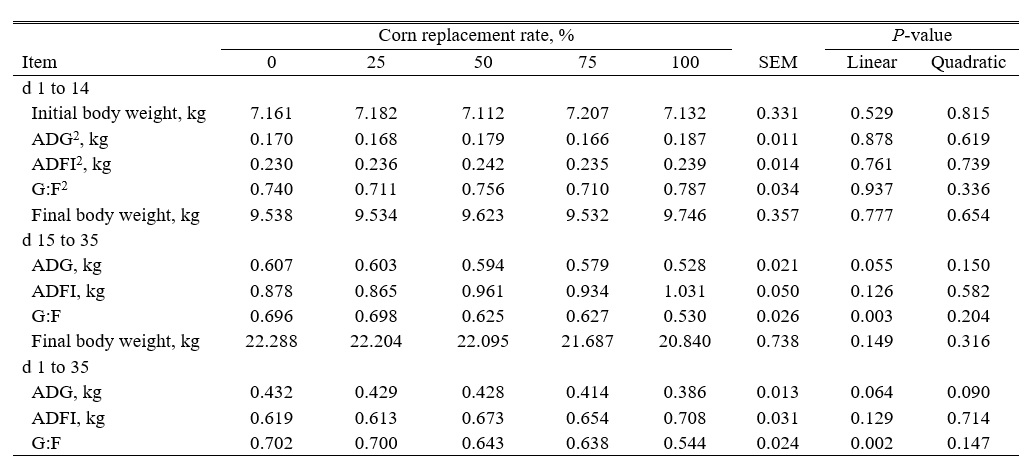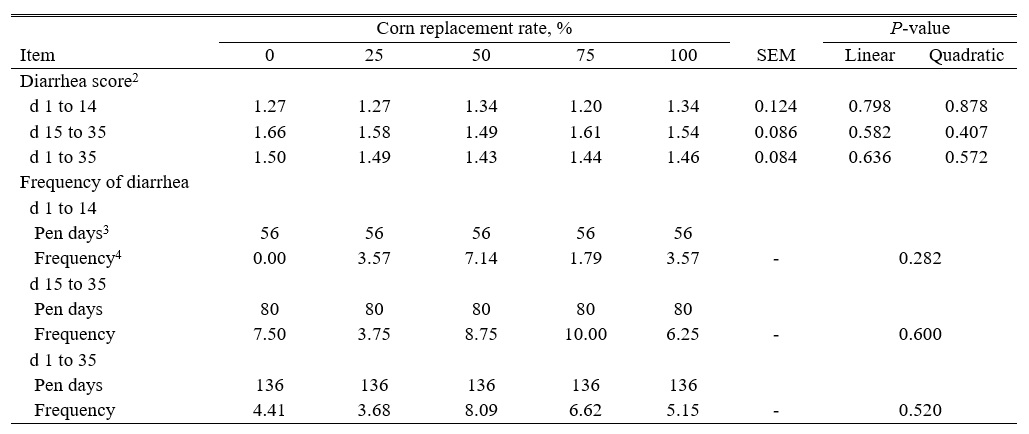



Bakery meal consist of unsalable bread, breakfast cereals, cookies, pasta, and other foods that are no longer intended for human consumption. Bakery meal converts losses from the food industry into ingredients for the animal feed industry, thereby preventing food losses in the food chain. Wheat flour is the main ingredient in most bakery products, and this results in bakery meal containing high concentration of starch. Therefore, bakery meal is a potential sustainable feed ingredient that can be used in animal diets without competing with the food industry. However, research demonstrating the effect of bakery meal on growth performance for weanling pigs is limited. Therefore, an experiment was conducted to test the hypothesis that replacing corn with bakery meal will not influence growth performance of pigs.
Experimental design
A total of 160 newly weaned pigs (initial body weight: 7.17 ± 0.94 kg) were allotted to 1 of 5 dietary treatments. A 2-phase feeding program was used with d 1 to 14 being phase 1 and d 15 to 35 as phase 2. There were 4 pigs per pen with 8 replicate pens per treatment. A total of 10 diets were formulated. In each phase, a control diet based on corn and soybean meal was formulated, and 4 additional diets included increasing concentrations of bakery meal at the expense of corn. In both phases, the replacement of corn with bakery meal was 0, 25, 50, 75, and 100%.
Individual pig weights were recorded at the beginning of the experiment, on d 14, and on d 35. Feed addition was recorded daily, and the weight of feed left in the feeder was recorded on d 14 and d 35. Growth performance data were summarized for d 1 to 14, d 15 to 35, and for the entire experiment. A blood sample was collected from one pig per pen on d 14 and again on d 35. Blood samples were analyzed for blood urea nitrogen (BUN), total protein, and albumin. Fecal scores were assessed visually every other day throughout the experiment.
Results
There was no effect of increasing concentrations of bakery meal on final body weight, ADG, ADFI, or G:F of pigs from d 1 to 14 (Table 1). Average daily gain of pigs from d 15 to 35 and for the overall experimental period tended to decrease (P < 0.10) as the concentration of bakery meal increased in the diets. Phase 2 and overall G:F linearly decreased (P < 0.01) as bakery meal inclusion increased in the diets. However, no differences among dietary treatments were observed from d 15 to 35 and in the overall experimental period for final body weight and ADFI. Likewise, increasing concentrations of bakery meal in diets did not affect fecal scores or diarrhea frequency of pigs (Table 2). Increasing level of bakery meal in diets did not affect the concentration of BUN, total protein, or albumin of pigs (Table 3).
Key points
- Increasing concentrations of bakery meal in pig diets did not affect final body weight, ADG, ADFI, and G:F from d 1 to 14.
- Increasing concentrations of bakery meal in pig diets reduced ADG and G:F from d 15 to 35 and for the overall experimental period.
- Increasing concentrations of bakery meal in diets did not affect fecal scores and blood characteristics of pigs.
- Based on these results it is recommended that bakery meal replaces only 25% of corn in diets for weanling pigs.
Table 1. Growth performance for pigs fed diets containing increasing levels of bakery meal1


1Data are least squares means of 8 observations for all treatments.
2ADG = average daily gain; ADFI= average daily feed intake; G:F = gain to feed ratio.
Table 2. Diarrhea score and frequency of diarrhea for pigs fed diets containing increasing levels of bakery meal1


1Data are least squares means of 8 observations for all treatments.
2Diarrhea score = 1, normal feces; 2, moist feces; 3, mild diarrhea; 4, severe diarrhea; 5, watery diarrhea.
3Pen days = number of pens × the number of days assessing diarrhea scores.
4Frequency = (number of pen days with diarrhea scores ≥ 3/pen days)*100.
Table 3. Blood characteristics for pigs fed diets containing increasing levels of bakery meal1


1Data are least squares means of 8 observations for all treatments.
2BUN = blood urea nitrogen.




